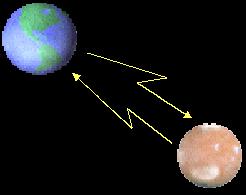
Distance communications are carried by electromagnetic radiation - commonly by radio waves, but increasingly by light. The speed of propagation of these carriers is about 300,000 kilometres per second - the speed of light (and all other electromagnetic radiation). While this is an incredibly high speed, it already causes problems in some of our day to day communication, and as we begin to contemplate interplanetary travel, we find that the finite or limited speed of light imposes serious limitations on our activities.

The table below indicates the communication delay that occurs in a one-way transmission.
| Circuit | Distance | Delay Time |
| HF link (UK-NZ) | ~20,000 km | 0.07 s (67 ms) |
| Submarine cable(UK-NZ) | ~20,000 km | 0.07 s (67 ms) |
| Geosat Link (US-Aus) | ~80,000 km | 0.25 s |
| Earth-Moon | 384,000 km | 1.3 s |
| Earth-Mars | 55 - 378 million km | 3 - 21 minutes |
| Earth-Jupiter | 590 - 970 million km | 33 - 53 minutes |
| Earth-Pluto | ~5800 million km | 5 hours |
| Earth-Nearest Star | ~40 million million km | 4 years |
Only the first two circuits listed have a delay that is barely noticeable in a two-way voice conversation. On telephone calls between continents that are routed via a geosynchronous satellite, the time between when one person stops speaking and then hears the other person reply is half a second. This can cause immense confusion if the other person starts speaking before the first has finished. It can take several sentences before the confusion is finally sorted out. Two-way digital communication between machines at high data rates suffers from this problem even more acutely, and protocols must be established which prevent conflicts arising.
Communication with a future lunar base will be worse, and for voice communications will necessitate an "over to you" simplex radio communications type approach. Two-way interactive communication with any station beyond the moon is basically impossible. Although there are no manned bases currently on other planets, this delay is presently of great concern to people who send remotely controlled spacecraft to Mars. There is no possibility of detecting an incipient vehicular crash in time to do anything about it. The vehicle must thus be given a very large degree of autonomous control (eg for navigation).
If we were to ever establish colonies on planets around other stars, we can essentially forget about communicating with them. This is not to say that we couldn't follow progress reports, but by the time we had replied, our advice would be totally irrelevant (particularly considering current political lifetimes of 3 to 5 years!). Unless of course, we manage to break the light barrier - something physics currently sees as impossible.